Exhibitions
2019-2 MOMAT Collection
Date
-Location
Collection Gallery, from the fourth to second floors
The collection exhibition from November 1, 2019 –February 2, 2020
Welcome to the MOMAT Collection! In this exhibition, we introduce currents in Japanese modern and contemporary art from the end of the 19th century to the present along with a variety of works from other countries.
The exhibition fills 13 rooms in all. In the Highlights section (Room 1, 4th floor), viewers are treated to a host of masterpieces selected from the museum collection. Rooms 2 to 13, arranged in roughly chronological order, have each been assigned a theme, enabling viewers to see the relationship between art and society in each era from a wide range of perspectives.
This time, during the exhibition’s first term (Nov. 1 – Dec. 15) only, 10 rooms on the 3rd floor will be the venue for a special exhibition, “Special Display of Rediscovered Tsukiji Akashi-cho Town by Kaburaki Kiyokata.”
Also, as a new initiative, there will be a special showing of Kobayashi Kohei’s To-Kai-Do-Chu-Hiza-Kuri-Ge (2016, private collection). This work draws inspiration from Jippensha Ikku’s Tokai dochu hizakurige (Shanks’ Pony along the Tokaido), a comical Edo Period (1603-1868) book known for its engaging back-and-forth between the characters Yaji and Kita, and parts of it are exhibited here and there in the galleries. Be on the lookout for them!
We hope that you will enjoy this edition of the MOMAT Collection, which includes a wide and varied assortment of works including oil painting, Nihonga (Japanese-style painting), sculpture, prints, photography, and video as well as a recently enriched collection of ceramics.
translated by Christopher Stephens
Important Cultural Properties on display
The National Museum of Modern Art, Tokyo Collection (main building) contains 15 items that have been designated by the Japanese government as Important Cultural Properties. These include nine Nihon-ga (Japanese-style) paintings, five oil paintings, and one sculpture. (One of the Nihon-ga paintings and one of the oil paintings are on long-term loan to the museum.)
The following Important Cultural Properties are shown in this period:
- Harada Naojiro , Kannon Bodhisattva Riding the Dragon, 1890, Long term loan (Gokokuji Temple Collection)
- Wada Sanzo, South Wind , 1907
- Yorozu Tetsugoro, Nude Beauty , 1912
- Nakamura Tsune, Portrait of Vasilii Yaroshenko, 1920
- Please visit the Important Cultural Property section Masterpieces for more information about the pieces.
About the Sections
MOMAT Collection comprises twelve(or thirteen)rooms and two spaces for relaxation on three floors. In addition, sculptures are shown near the terrace on the second floor and in the front yard. The light blue areas in the cross section above make up MOMAT Collection. The space for relaxation “A Room With a View” is on the fourth floor.
The entrance of the collection exhibition MOMAT Collection is on the fourth floor. Please take the elevator or walk up stairs to the fourth floor from the entrance hall on the first floor.
4F (Fourth floor)
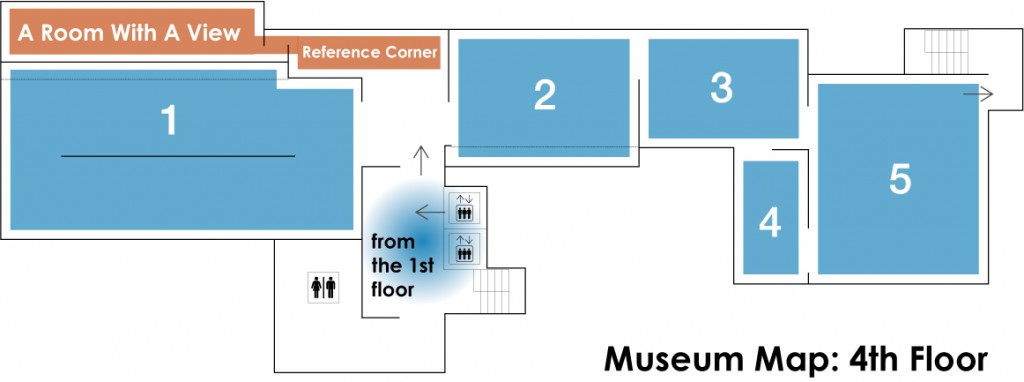
Room 1 Highlights * This section presents a consolidation of splendid works from the collection, with a focus on Master Pieces.
Room 2– 5 1900s-1940s
From the End of the Meiji Period to the Beginning of the Showa Period
A Room With A View
Reference Corner
Room 1 Highlights
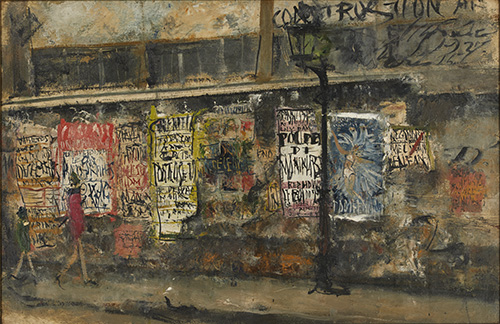
The MOMAT Collection, drawn from the museum’s holdings, consists of over 200 works displayed over a 3,000-square meter area. To start the exhibition, we present the “Highlights” section, consisting of some of the collection’s most essential works including Important Cultural Properties.
This time, from our Nihonga (Japanese-style painting) collection, during the exhibition’s first term (Nov. 1 – Dec. 15) only we present a “Special Display of Rediscovered Tsukiji Akashi-cho Town by Kaburaki Kiyokata,” and in conjunction with this we are also exhibiting Kaburaki’s Boating-Excursion on the Sumida River, which won an award at the 8th Bunten (annual exhibition sponsored by the Ministry of Education). During the second term (Dec. 17 – Feb. 2, 2020) Hishida Shunso’s Crow and Sparrows, said to be a bequest of Emperor Meiji who reigned from 1867 to 1912.
Various genres of crafts, including ceramics, textiles, metalwork and woodwork, are exhibited side by side. Please note the materials and techniques of each work as you appreciate them.
Yoga (Japanese Western-style painting) on view includes Harada Naojiro’s Kannon Bodhisattva Riding the Dragon and Nakamura Tsune’s Portrait of Vasilii Yaroshenko, both Important Cultural Properties, and other major works from successive eras up to the 1940s. The popular painter Fujita Tsuguharu’s Five Nudes, from his time in Paris, and war painting Final Fighting on Attu will both be exhibited, offering an intriguing opportunity for comparison. Also, please enjoy the works of overseas artists, such as Paul Cezanne and Auguste Rodin, who were a great influence on Japanese artists.
Room 2 1912
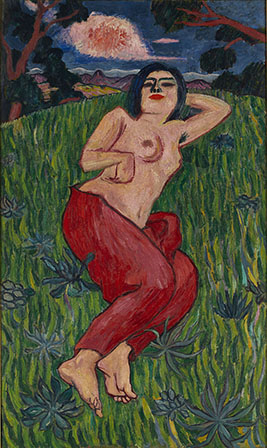
Two Important Cultural Properties, Wada Sanzo’s South Wind and Yorozu Tetsugoro’s Nude Beauty, are exhibited side by side. In both, the figure in the center of the painting strikes a bold attitude and wears only a red cloth wrapped around the waist. One is a strapping muscular man, and the other a woman lying languorously on the grass. Next to Nude Beauty is Leaning Woman, another female nude painted by Yorozu five years later. The dates of these paintings place South Wind near the end of the Meiji Era (1868-1912), Leaning Woman near the beginning of the Taisho Era (1912-1926), and Nude Beauty just between the two in 1912, the year of transition from Meiji to Taisho.
If art of the Meiji Era was strongly connected to creation of a new cultural identity as Japan began to evolve as a modern nation-state, Taisho art is characterized by respect for artists’ individual viewpoints. As if battling the moderate realism approved by the official Bunten – an annual exhibition sponsored by the Ministry of Education, which began in 1907 – these artists developed new styles one after another as they absorbed various European movements such as Fauvism, Cubism and Futurism.
Room 3 September 1, 1923 The 10th Nika Exhibition
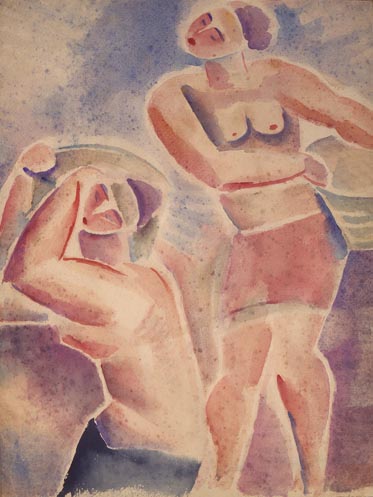
In words attributed to the physicist Terada Torahiko, “Natural disasters strike just when we have forgotten their existence.” At 11:58 AM on September 1, 1923, a massive earthquake with a magnitude of 7.9 hit the Kanto region. The damage from resulting fires was much greater than that caused by buildings’ collapse due to seismic vibrations, and the blaze that broke out immediately after the earthquake swept through central Tokyo and burned most of it to the ground.
When the earthquake struck, Terada was in Ueno to see the 10th Nika Exhibition and had dropped by a café with his friend the painter Tsuda Seifu, and he wrote about the experience with a physicist’s unique insights. The Nika Exhibition was a public open-call exhibition organized by the Nika Association, a group of artists dissatisfied with the official salons Bunten and Teiten, annual exhibitions sponsored by the Ministry of Education and Teikoku Bijutsu-in (the Imperial Academy of Fine Arts) respectively. For the 10th edition a special display of works by contemporary French painters such as Henri Matisse and George Braque was planned. Due to the earthquake, the exhibition in Tokyo was canceled after just one day, but it traveled to Osaka in October.
In this room we present works of the 1920s and explore the relationship between art and the 1923 earthquake, with a focus on works shown at the 10th Nika Exhibition.
Room 4 (1) Kawase Hasui, Traveling Printmaker (Exhibit Date: November 1 – December 15, 2019)
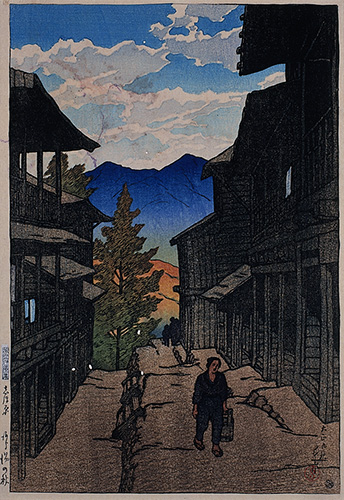
Kawase Hasui was known as a “traveling printmaker” whose works depicted landscapes in various parts of Japan with a fresh sensibility. He was involved in the movement to restore the art of ukiyo-e prints (specifically nishiki-e, colored woodblock prints), which had been in decline since the Meiji Era (1868–1912), and like traditional nishiki-e, this work was produced in collaboration among hanmoto (publishers), eshi (artists), horishi (carvers), and surishi (printers).
Kawase decided to become a printmaker in 1918, after studying Nihonga (Japanese-style painting) under Kaburaki Kiyokata and oil painting under Okada Saburosuke. In the Kawase Hasui Guide to Creative Prints, published in conjunction with a 1921 exhibition, Kiyokata contributed a strong message of encouragement: “Kawase’s journey will surely never come to an end.”
When asked what he liked to do, Kawase would immediately respond “Travel!” Scenes from Travels I was his first series of works based on sites he had visited, and it determined his stylistic path. The following year he produced Scenes from Travels II, the result of a trip to the Kansai and Hokuetsu regions, and Scenes from Travels III was his first series after the Great Kanto Earthquake of 1923. Here, in addition to Kawase’s works from the 1910s and 1920s, we present Scenes from the Tokaido Highway, an example of his work from the 1930s onward.
Room 4 (2) Onchi Koshiro, Abstract Pioneer Printmaker (Exhibit Date: December 17, 2019 – February 2, 2020 )
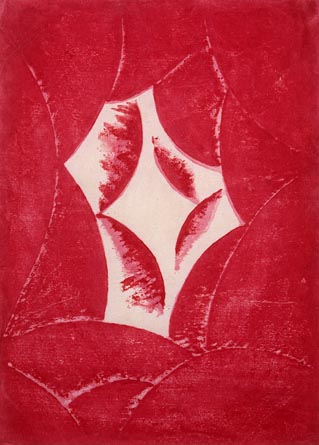
Printmaker Onchi Koshiro was a pioneer of abstraction in Japan. Here we present his works up through the prewar period of the late 1920s and early 1930s, with a focus on the abstract art he began producing in the 1910s.
In his teenage years Onchi studied under Takehisa Yumeji, and in 1914, he and Tokyo School of Fine Arts students Tanaka Kyokichi and Fujimori Shizuo launched the magazine Tsukuhae, which combined woodcuts and poetry. His Lyric series, said to be the first abstract art ever produced in Japan, appeared in the pages of Tsukuhae. Onchi said of Lyric: “All things are driven by life force. Shining with beauty beyond all beauty, this force powerfully binds together every part of our lives. It rushes forth from the depths of the heart. The entirety of our emotions becomes a vibrating form. The heart flows into the hand, and the hand runs over the paper. This is the source of my Lyric series.” (“On the Lyrical in Art,” Emotion no. 20, 1918.) Please enjoy this survey of the development of Onchi’s abstraction, beginning with the semi-abstract An Idiot’s Wish containing what appears to be a human silhouette looking up at the heavens, progressing through Lyric: “The Clear Hours”, composed of multiple intersecting arcs, to Lyric: Blessing for Efforts, produced by printing layers of semi-transparent colors.
Room 5 The 1930s Modern Experimentation and Maturation
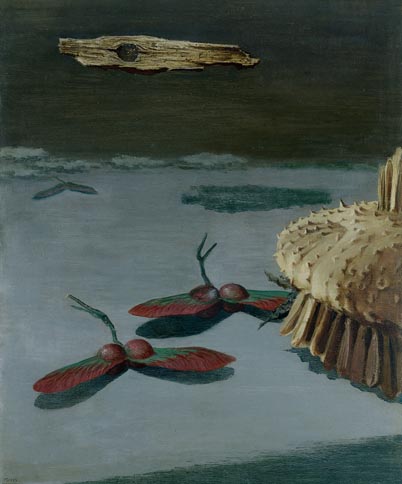
This room introduces art movements of the 1930s, with a spotlight on several topics. These include the activities of galleries that served as forums for avant-garde art. It was during this period that many small galleries such as Kinokuniya Gallery (Shinjuku: 1927, Ginza: 1932) emerged as venues for artists pursuing forward-looking, experimental art, in contrast to the official salons – the Bunten and the Teiten, annual exhibitions sponsored by the Ministry of Education and Teikoku Bijutsu-in (the Imperial Academy of Fine Arts) respectively – and public open-call exhibitions such as the Nika Exhibition. The new galleries, located in central urban areas, offered artists a more accessible alternative means of reaching audiences.
Another feature of this period was the maturation of Western-style painting. Artists such as Yasui Sotaro and Umehara Ryuzaburo, having studied extensively during the Meiji (1868-1912) and Taisho (1912-1926) eras, aimed for a fusion of Western realism and native Japan-rooted sensibilities, rather than imitation of the West – described metaphorically as “cut flowers” – and came to full maturity during this period.
Also, during this time an increasing number of painters crossed national borders. While Yasui, Umehara and their contemporaries explored Japanese approaches to oil painting, other Japanese painters traveled to Europe and the Americas and worked there on an ongoing basis. Another intriguing figure is Paul Jacoulet, a French printmaker who grew up in Japan and continued working there throughout his life.
3F (Third floor)
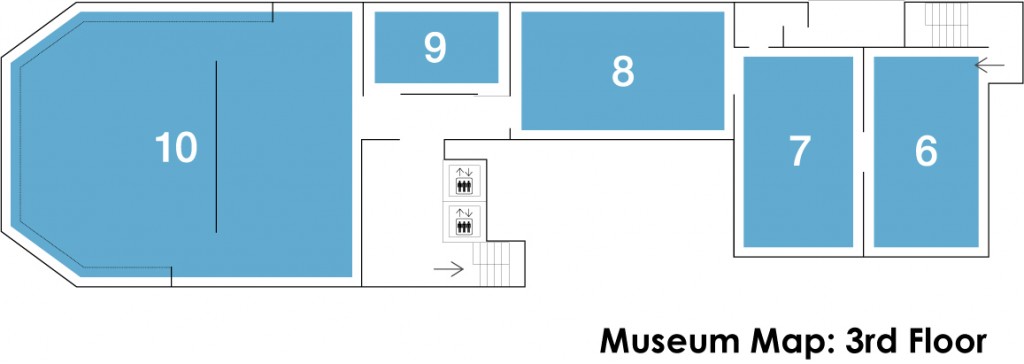
Room 6-8 1940s-1960s
From the Beginning to the Middle of the Showa Period
Room 9 Photography and Video
Room 10 Nihon-ga (Japanese-style Painting)
Room to Consider the Building
Room 6 1943 The 2nd Great East Asia War Art Exhibition
Military art, also known as war record paintings, was art officially commissioned by the Japanese military to document World War II in the Asia-Pacific region. The military chose themes, painters were dispatched to battle zones to gather material and produce works, and after completion the wartime authorities collected the works and exhibited them in various locations around Japan. Here, we present paintings from the 2nd Great East Asia War Art Exhibition, held at the Tokyo Metropolitan Art Museum in December 1943 and January 1944. This was one of the largest exhibitions of such art during the war, and also traveled to Osaka, Kyoto, Fukuoka, Sasebo, and Nagoya over the course of six months. During 1943 Japan’s situation had worsened, with various setbacks including withdrawal from Guadalcanal, the total annihilation of the forces defending Attu, and the departure of students for the front, while at home people’s living conditions were growing increasingly severe. Nonetheless, according to the Tokyo exhibition’s organizers, the number of attendees exceeded 150,000 in one month.
All of the works in this room were originally shown at the 2nd Great East Asia War Art Exhibition. What did people see, what did they think about, when they viewed the works at that time, and how do they appear to us today?
Room 7 The 1950s (1) The Atomic Age and the Children’s Art Boom
Here we focus on two topics relating to art of the 1950s. First, it was the “Atomic Age”: Eight years after atomic bombs were dropped on Hiroshima and Nagasaki in 1945, in the midst of the Cold War, US President Dwight D. Eisenhower gave his “Atoms for Peace” speech at the United Nations General Assembly. The peaceful use of nuclear energy was much discussed in the 1950s, and the theme was also actively explored in the arts (in Japan, the comic Astro Boy [a.k.a. Mighty Atom] featuring the nuclear-powered robot was serialized starting in 1952, and the movie Godzilla, about a monster awakened by a hydrogen bomb test, was released in 1954). Also, it was a golden age for children’s art. Japan’s children’s art boom was touched off by the group Sozo Biiku Kyokai (Creative Art Education Association), which involved the painter Kitagawa Tamiji and others, which focused on theory and practice aimed at liberating children’s hearts and minds. Art by children moved beyond the classroom, appearing in the Nihon Independants exhibition alongside works by professional artist, and the novelist Kaiko Takeshi won the Akutagawa Prize for literature in 1957 for The Emperor’s New Clothes, the theme of which was children’s art education. In 1954 the Exhibition of World Children’s Art was held at this museum, and children’s drawings and paintings were exhibited as “works of art,” while children’s works from this time remain in the collection today as “materials.”
Room 8 The 1950s (2) Zen’ei Bijutsukai and the Nipponten
In 1953, the Nipponten (Nippon Exhibition) was held at the Tokyo Metropolitan Art Museum. The exhibition included Yamashita Kikuji’s The Tale of Akebono Village and Kawara On’s Bathroom series (November 1 – December 15), both of which came to be indispensable to any discussion of 1950s art in Japan.
The left-wing artist collective Zen’ei Bijutsukai (Avant-garde Art Society) were co-organizers of the exhibition. Various artists such as Maruki Iri and Maruki Toshi (née Akamatsu Toshiko) – known for The Hiroshima Panels – Yamashita Kikuji, and Iwasaki Chihiro, now known as a picture book creator, were members of the group, which was formed shortly after World War II in 1947 and began holding the Zen’ei Bijutsuten (Exhibition of Avant-garde Art) the same year. For the seventh exhibition, held in 1953, the Zen’ei Bijutsukai provided the venue they had secured at the Tokyo Metropolitan Art Museum to Seinen Bijutsuka Rengo (Japan Federation of Young Artists), a group of artists opposed to war and to the mainstream art world, to which Zen’ei Bijutsukai member Yamashita Kikuji also belonged. This was known as the Nipponten. In this room we present art from the 1950s, with a focus on Zen’ei Bijutsukai and the Nipponten.
Room 9 NARAHARA Ikko Stateless Land
Here we present one of Narahara Ikko’s earliest works, Stateless Land, which was shot in parallel with his debut Human Land. In contrast to Human Land, which is about people living in an isolated area, it is an introspective work depicting an almost entirely unpopulated space.
For Narahara, who grew up during the wartime era and experienced Japan’s defeat in his mid-teens, social spaces in the postwar period were “like a vacuum, with more of a sense of emptiness and futility than of peace.” The setting of the work, the ruins of a munitions factory abandoned after the war, can be seen as a symbol of the empty, futile society he saw. The selection of this shooting location may have been a means of solidifying his stance as a photographer and as a young man.
At this time Narahara was a graduate student studying art history, and was friendly with other young artists of the same generation. Two works from Kawara On’s Bathroom series (on view until December 15 in Room 8) are known to have originally been purchased by Narahara from Kawara. Note the contemporaneous nature of Narahara’s Stateless Land and the works of Kawara, Bathroom and Events in a Warehouse (on view from December 17).
Room 10 (Exhibit Date: December 17, 2019 – February 2, 2020 ) “Eyes of Artists, Eyes of Insects” and The Sea Battle Between the Genji and the Heike
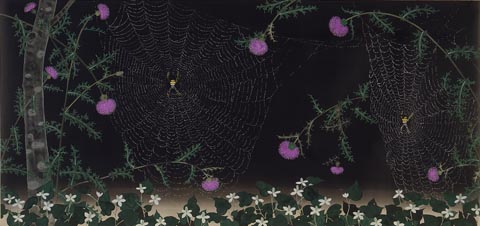
In the area in the back, we present works depicting small living things such as flowers and insects. There is none of the rich tapestry of scent, sound, and movement you would experience when standing in a real field or forest. Unfortunately, you cannot pick and eat wild strawberries or loquat fruits. However, with works by various artists arranged in this way, we hope you will experience various perspectives one after another, and encounter various aspects of nature that cannot normally be seen by a single person’s eye. The artists’ styles and techniques, their delicate drawing and decorative color surfaces, give a sense of the pictorial resolution at which painters view the world. With perspectives ranging from micro to macro, their gazes are truly diverse. And perhaps while viewing the insects on whom these artists trained their gaze, you will also imagine the way the world looks through these insects’ eyes.
In the area closer at hand, we are pleased to present all at once the five large works from Nakamura Masayoshi’s The Sea Battle Between the Genji and the Heike series, created for the Kobayashi Masaki-directed film Kwaidan: Stories and Studies of Strange Things (1965) based on the book by Koizumi Yakumo (Lafcadio Hearn).
2F (Second floor)
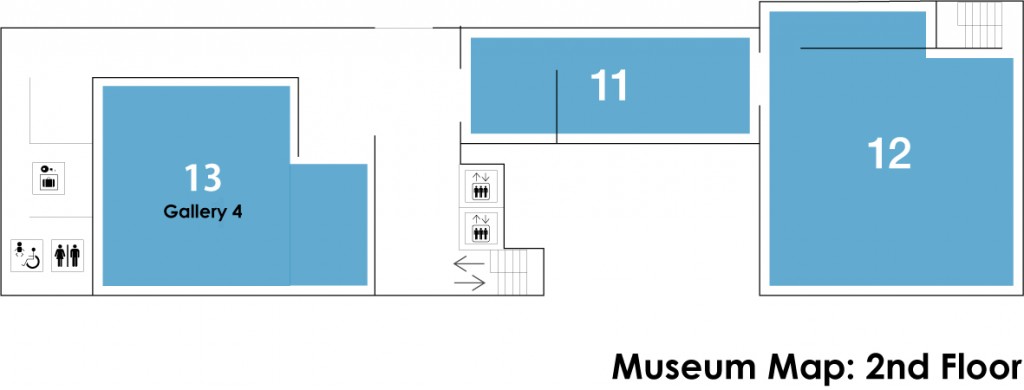
Room 11-12 1970s-2010s
From the End of the Showa Period to the Present
Room13(Gallery 4)
* A space of about 250 square meters. This gallery offers cutting-edge thematic exhibitions from the Museum Collection, and special exhibitions featuring photographs or design.
Room 11 The 1960s Two Non-Museum Sites
Here we introduce art movements of the 1960s with a focus on two key sites. The first of these is Minami Gallery, a contemporary art gallery founded by Shimizu Kusuo (1926-1979) in 1956 next to the Takashimaya Department Store in Nihombashi, Tokyo. While showing major Japanese postwar artists such as Yamaguchi Takeo, he also gained great success with a 1959 exhibition of Jean Fautrier to which the artist himself was invited. Throughout the 1960s and 1970s, the gallery exhibited contemporary art from Japan and overseas and continued to attract attention as a cutting-edge art gallery that wielded great influence.
The second is public urban spaces Hi-Red Center was formed in spring 1963 by Takamatsu Jiro, Akasegawa Genpei and Nakanishi Natsuyuki, its name an English translation of the first kanji characters in each of the members’ family names. They looked beyond art galleries, actively venturing out into public urban spaces where they staged events and happenings such as “Be Clean! Campaign to Promote Cleanliness and Order in the Metropolitan Area,” a guerilla street cleaning in the Ginza district during the 1964 Tokyo Olympics. Their activities blurred boundaries between art and daily life. Here, we present materials related to their activities, particularly the “Shelter Plan” event held at the Imperial Hotel, Tokyo.
Room 12 The 1970s and 1980s Unique, Yet Similar
Regarding the history of modern Japanese art handled by this museum, relationships with the West have always been a major issue, and these have often been discussed in terms of imitation and reception. In contrast to this asymmetrical relationship, in relation to postwar art the word “contemporaneous” is increasingly used. This applies when art from Japan is distinct and not an imitation of something from the West, but similarities to this art can be found in contemporary Western works. “Contemporaneity” encompasses the nuances of “unique yet similar,” and there remain questions about how to evaluate the Galapagos-like phenomenon of art that has evolved separately from the rest of the world.
Here works by Japanese and non-Japanese artists are exhibited side by side based on the thematic similarities of tables, boxes, staining, or regular repetition. Please take a moment to see if such pairings seem like arbitrary choices on the part of the curators, or if there is sufficient contemporaneity to make this presentation inevitable. This contemporaneity (uniqueness/similarity) leads to the question of how Japanese postwar art is evaluated and historically positioned (incidentally, in Japan today, art of the 1980s is in the process of being historicized.)
Room13(Gallery 4) The 1970s and 1980s Unique, Yet Similar
This room primarily contains works from the 1990s, contemporaneous with other works outside the room by Tanaka Koki, Julian Opie and Antony Gormley. And here Kobayashi Kohei’s To-Kai-Do-Chu-Hiza-Kuri-Ge, pieces of which are scattered throughout the Collection exhibition, are finally side by side with works from the same time period.
The concept of Kobayashi’s work is “traveling Jippensha Ikku’s Tokai dochu hizakurige (Shanks’ Pony along the Tokaido) by appreciating objects.” The issues of “appreciation” and “travel” in this work are connected to this entire exhibition of works from the museum’s collection, an observation (or appreciation) of the “journey” of modern art’s development in Japan. It is important that the instructions for “appreciation” that play out in Kobayashi’s work diverge from the unilateral pattern of “teaching and learning” that we usually imagine. The instructor occasionally receives pushback from the instructed, but Kobayashi says that this “places the creator and the viewer the same distance from the original work.” And he says that “the relationship encourages observation of the object and at the same time amplifies the concept and the image. Amplified, the work has already gone beyond both creator and viewer.” At the end of this “journey” through the museum’s collection, how have you engaged with these various works that transcend both artist and viewer?
Event
Let’s Talk Art!
Enjoy a cross-cultural conversation in English while exploring modern Japanese art.
pre-registration necessary
- Location
-
Meeting in the museum lobby (1st floor)
- Date
-
Every Friday
- Time
-
6:30PM–7:30PM (meeting time 6:15PM)
- Admission
-
Fee (including museum admission)
Adult (18–64) 1,500 yen
Discount with ID below (Show your ID)
College student 1,250 yen
Senior (65+) or Minor (11–17) 1,000 yenTickets on the day
If there are any vacancies, tickets are available at the museum ticket office from 10:00 AM to 6:15 PM on the day. - Pre-registration
- This is an English conversation gallery program.
- For international visitors
- For people aged 11 or over
- Late comers can neither participate in the session nor get refunds.
About the Exhibition
- Location
-
Collection Gallery, from the fourth to second floors
- Date
-
November 1, 2019 –February 2, 2020
- Time
-
10:00 – 17:00 (10:00 – 20:00 on Fridays and Saturdays)
*Last admission is 30 minutes before closing. - Closed
-
Mondays (except November 4, 2019 and January 13, 2020), ; November 5,2019; December 28, 2019 – January 1 and January 14,2020
- Admission
-
Adults ¥500 (400)
College and university students ¥250 (200)
*The price in brackets is for the group of 20 persons or more. All prices include tax.
Free for high school students, under 18, seniors (65 and over), Campus Members, MOMAT passport holder.
*Show your Membership Card of the MOMAT Supporters or the MOMAT Members to get free admission (a MOMAT Members Card admits two persons free).
*Persons with disability and one person accompanying them are admitted free of charge.
*Members of the MOMAT Corporate Partners are admitted free with their staff ID. - Discounts
-
Evening Discount (From 17:00 on Fridays and Saturdays)
Adults ¥300
College and university students ¥150 - Free Admission Days
-
Collection Gallery
Free on November 3, December 1, 2019, January 2, 5, February 2, 2020 - Organizer
-
The National Museum of Modern Art, Tokyo


